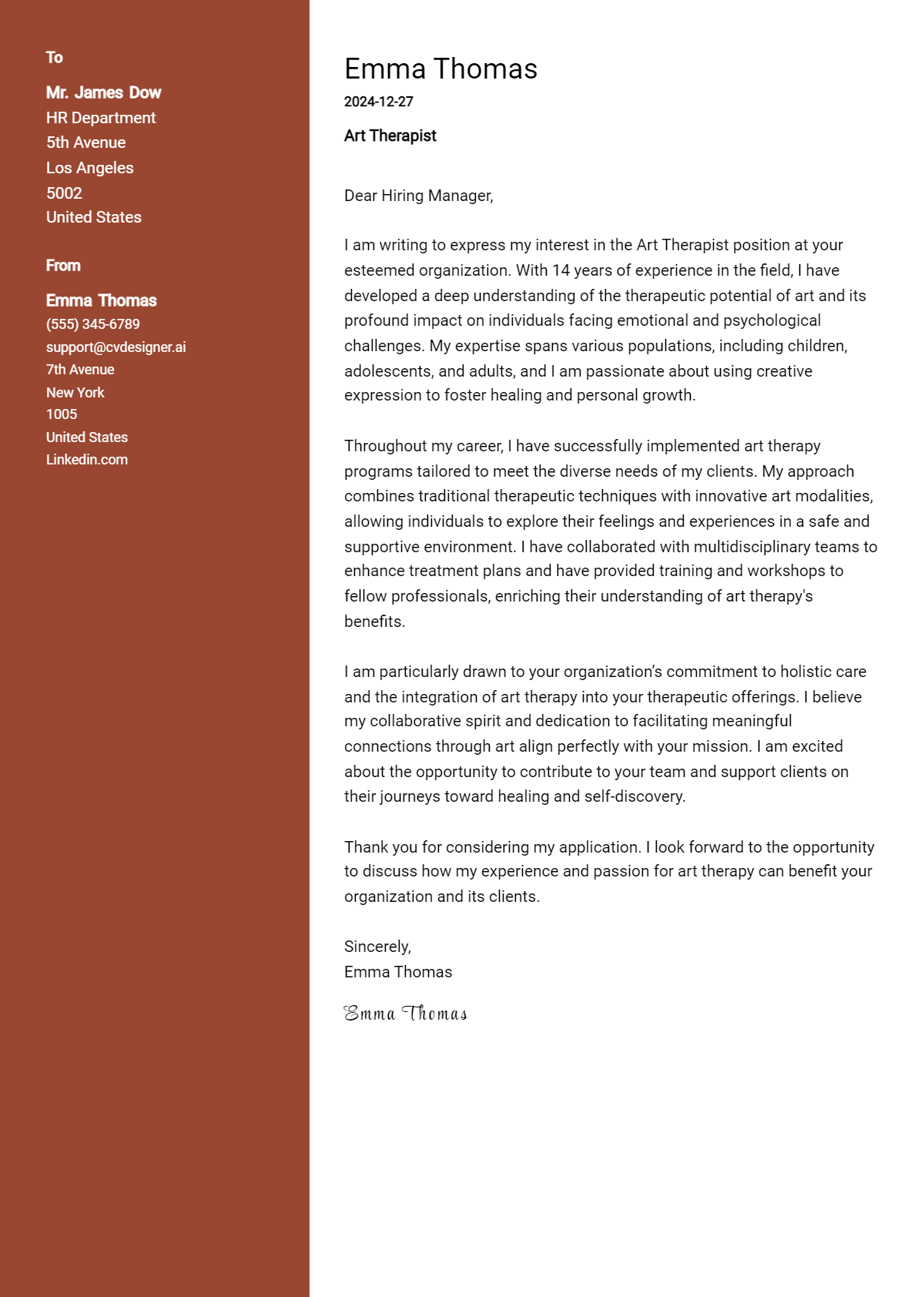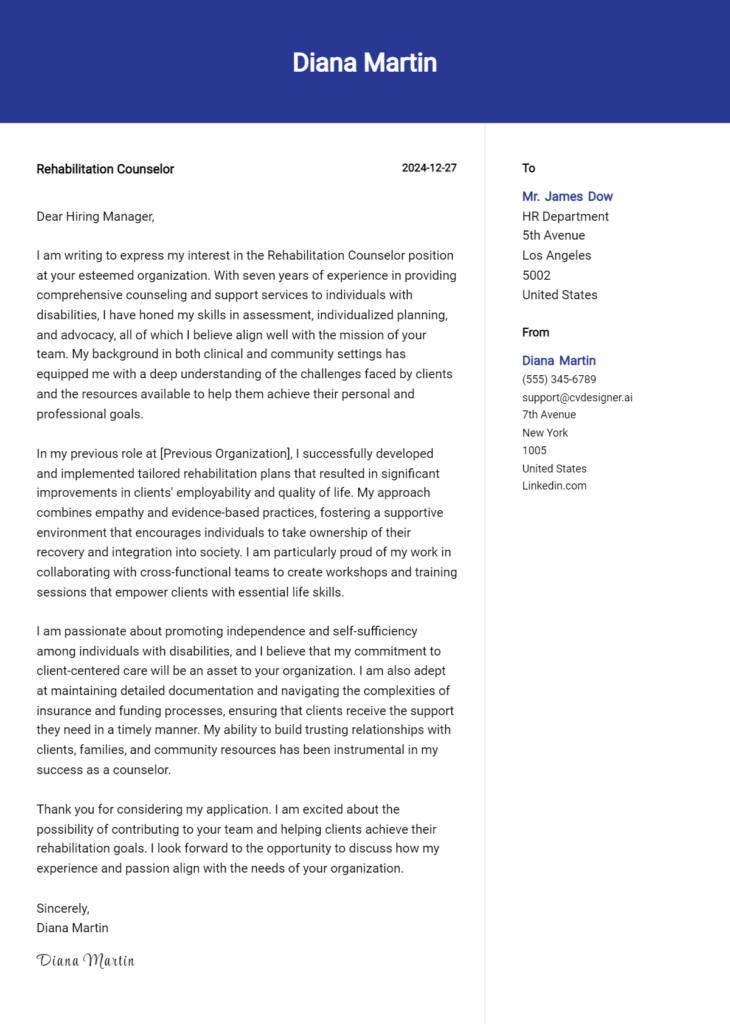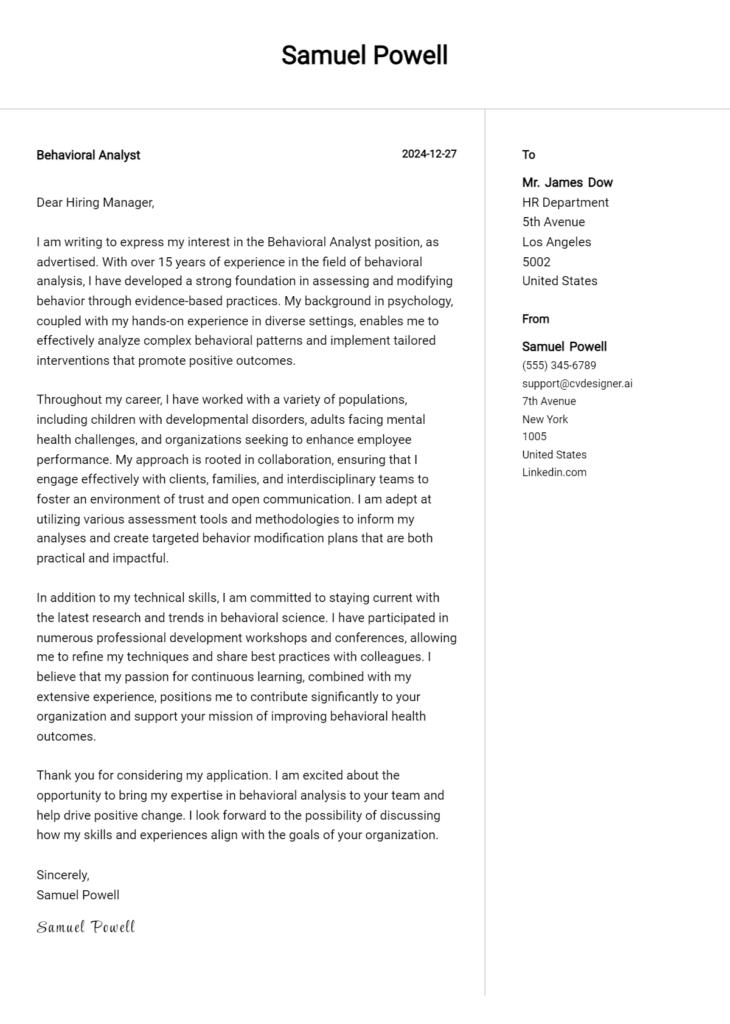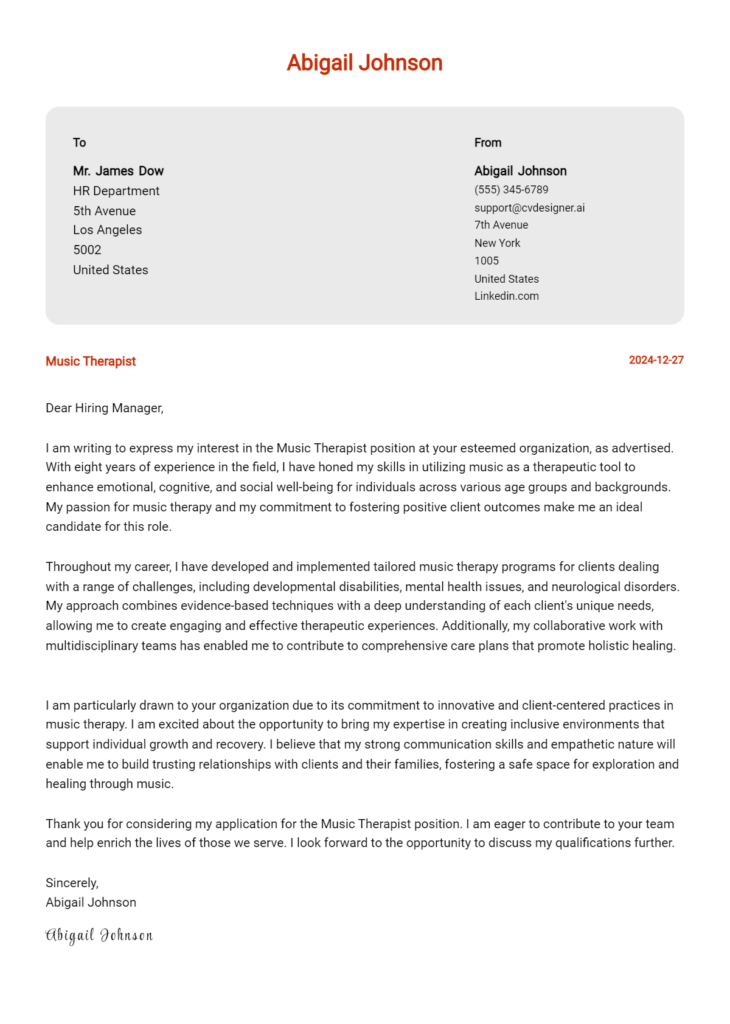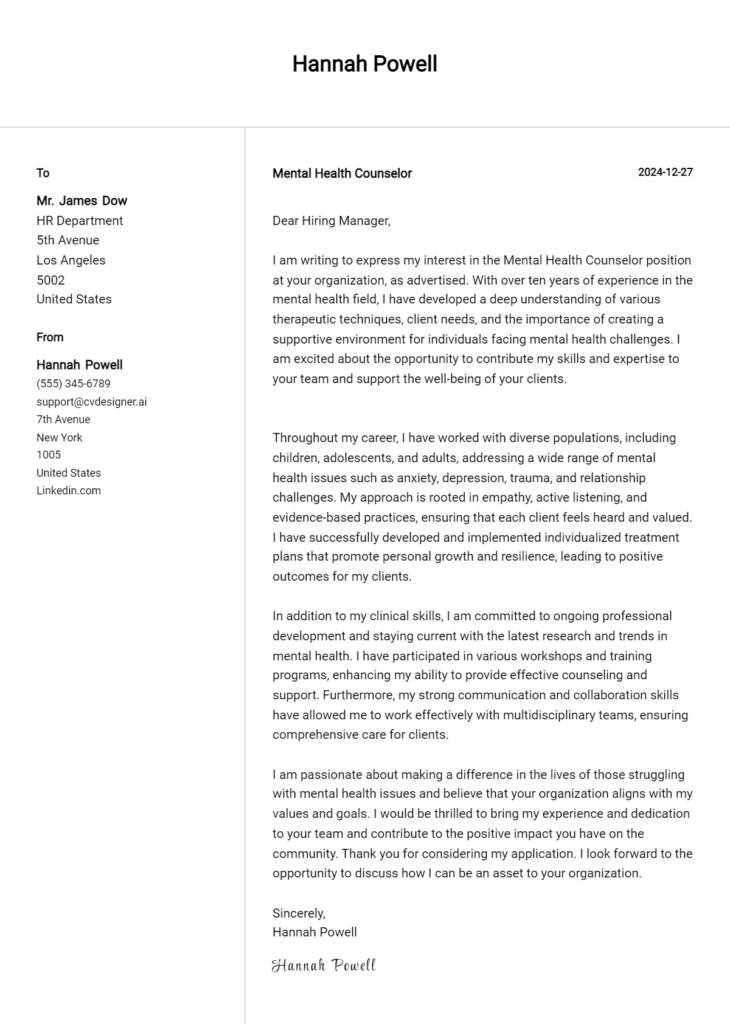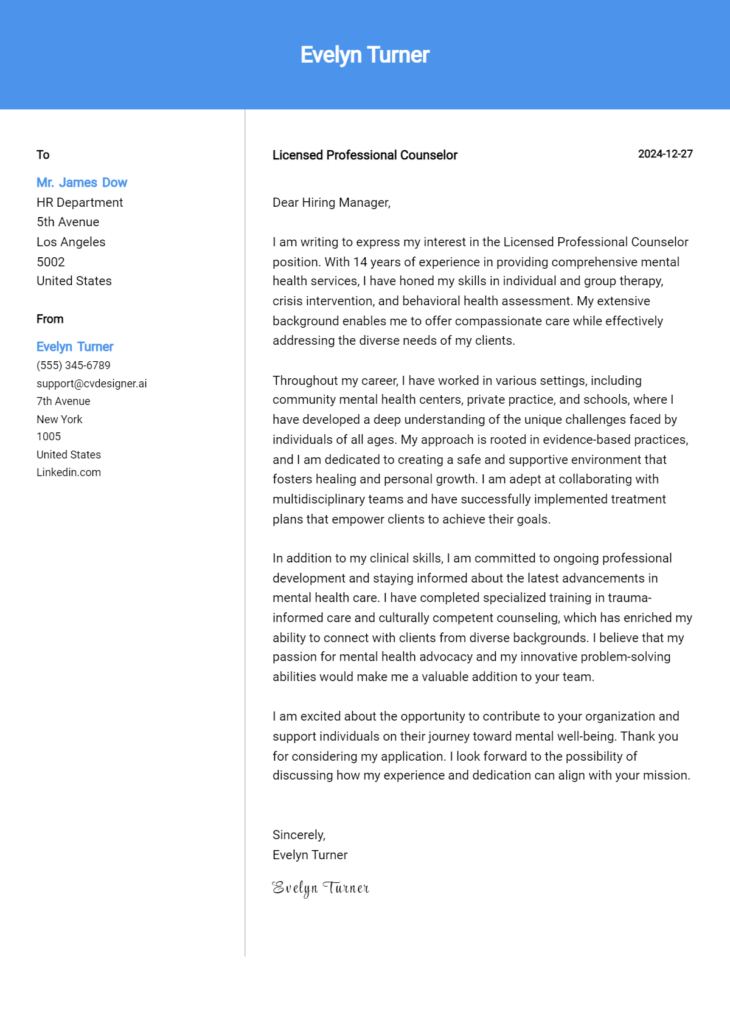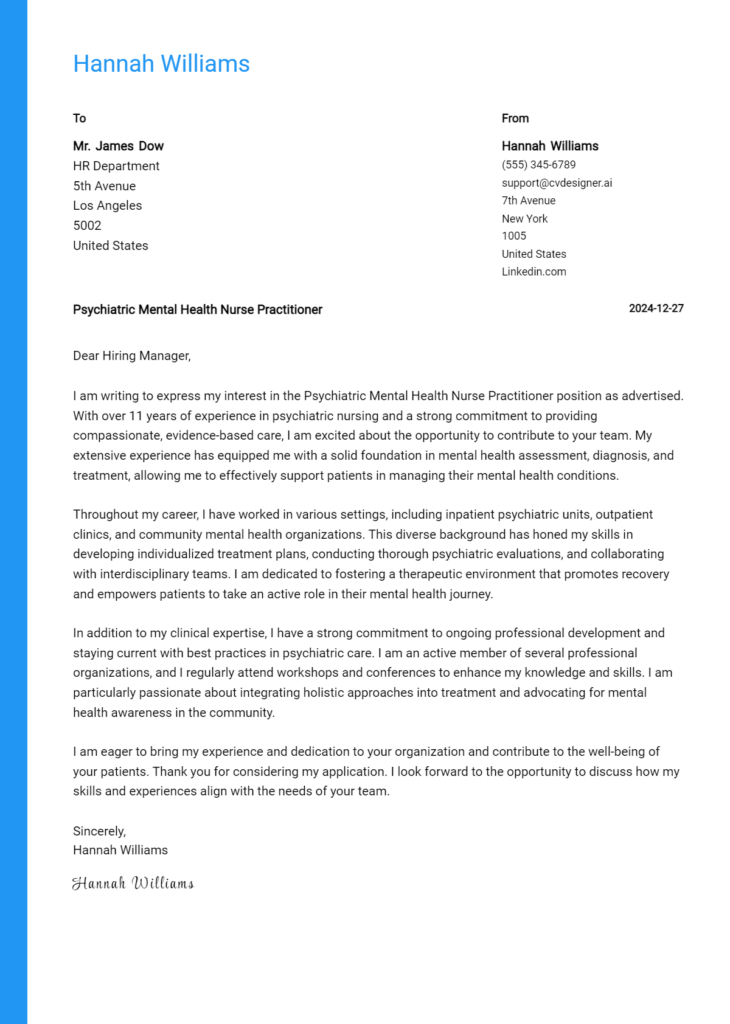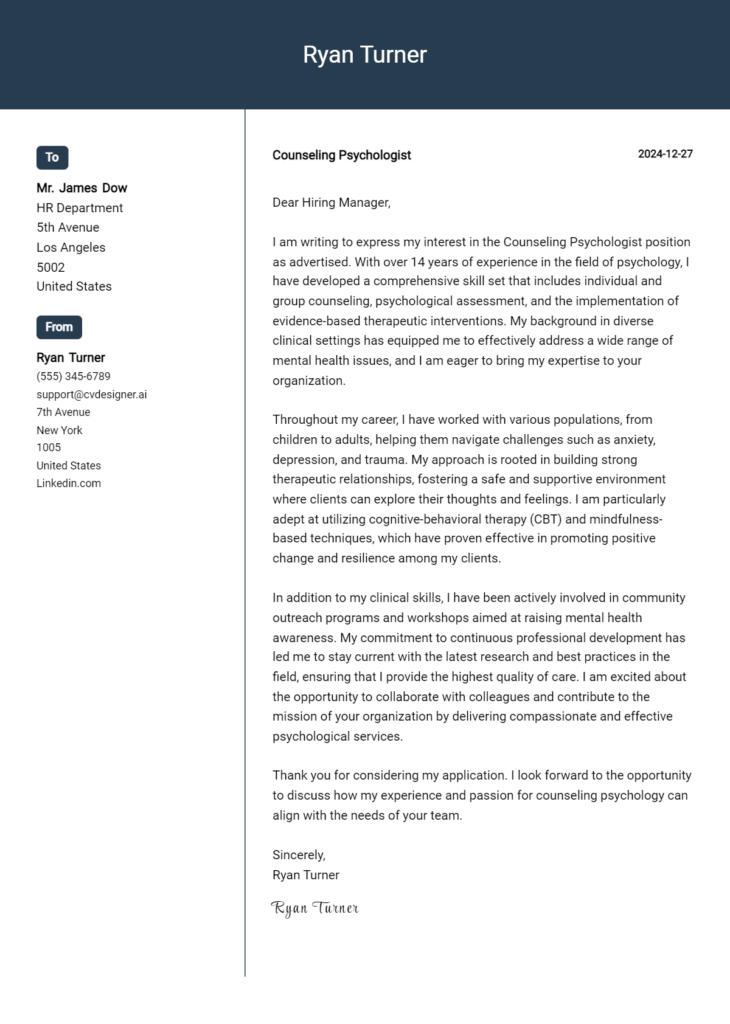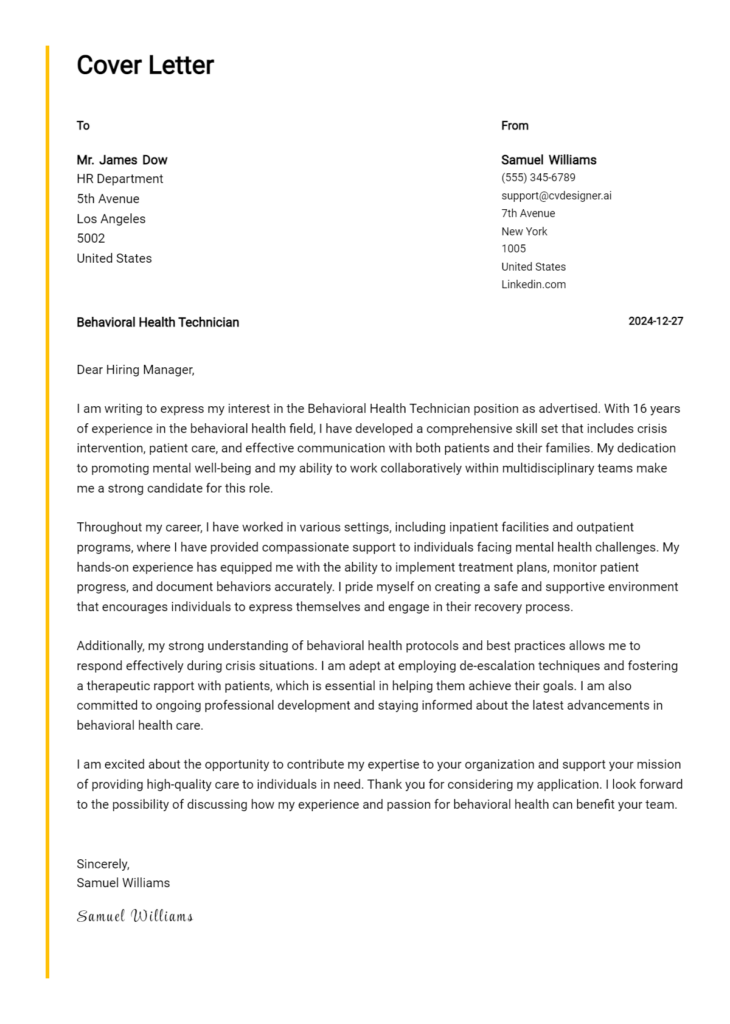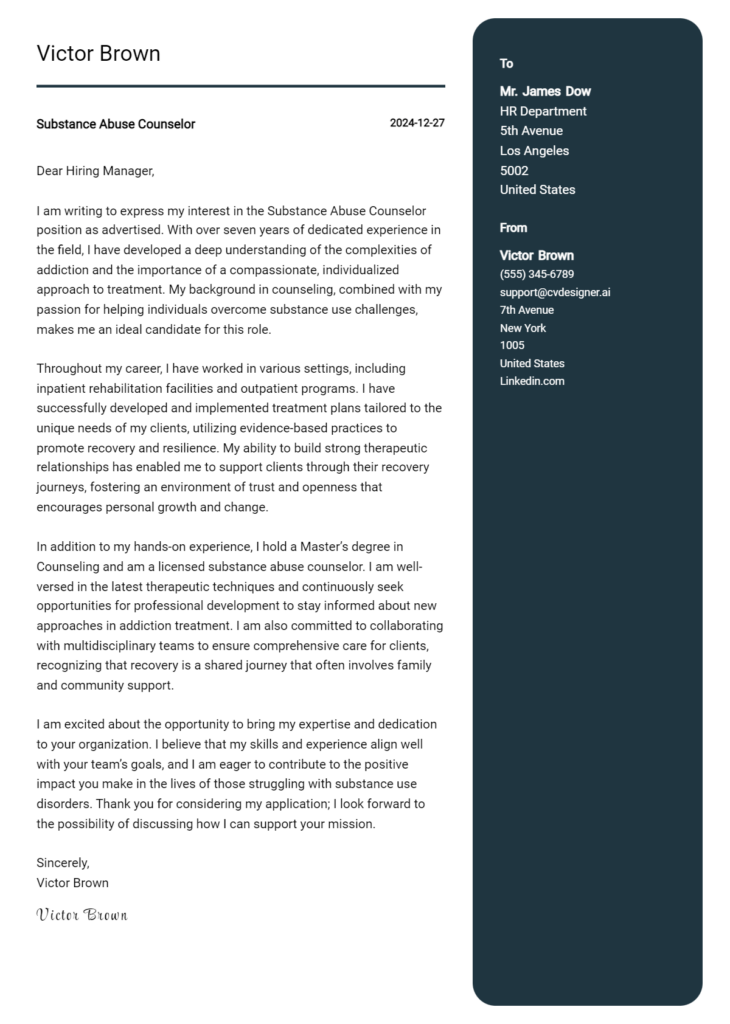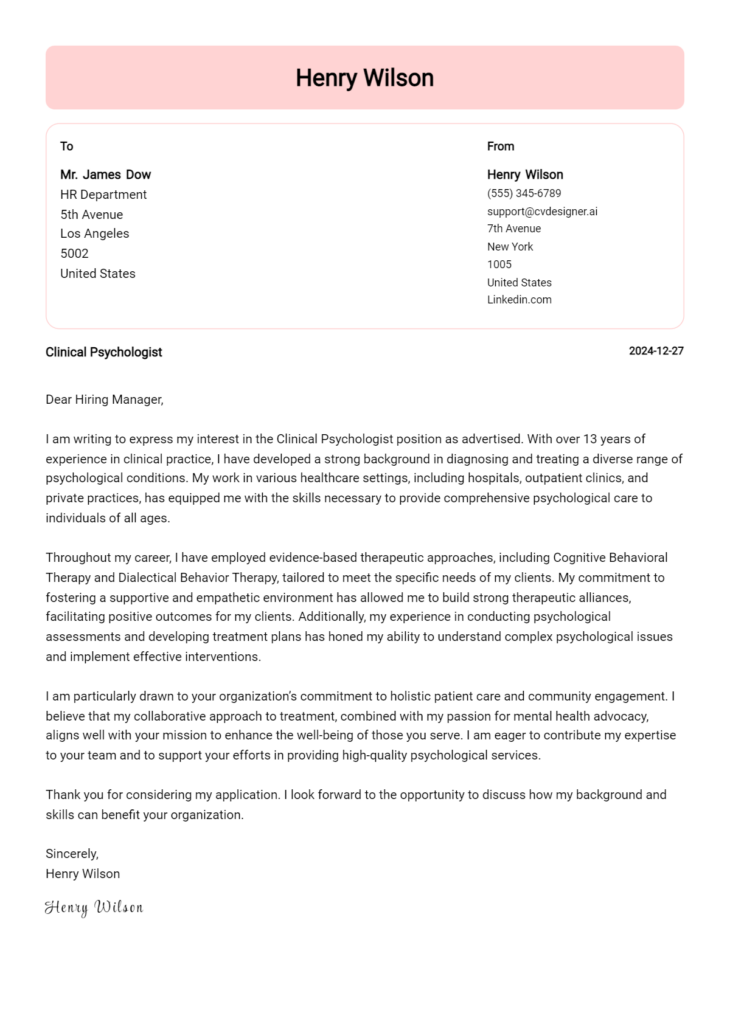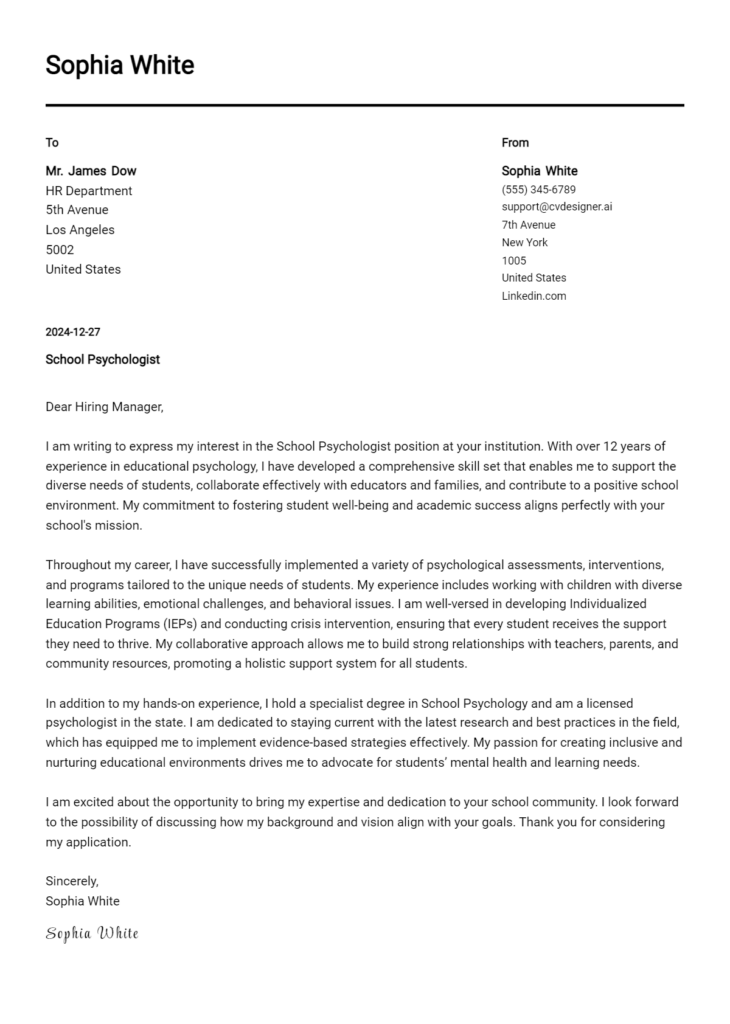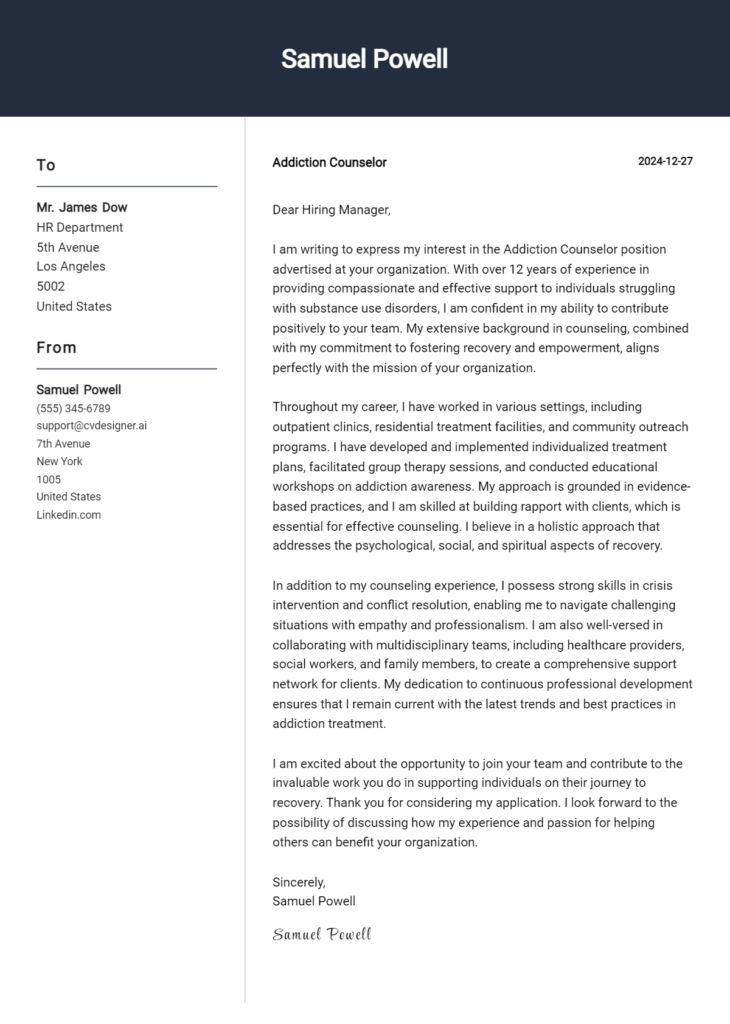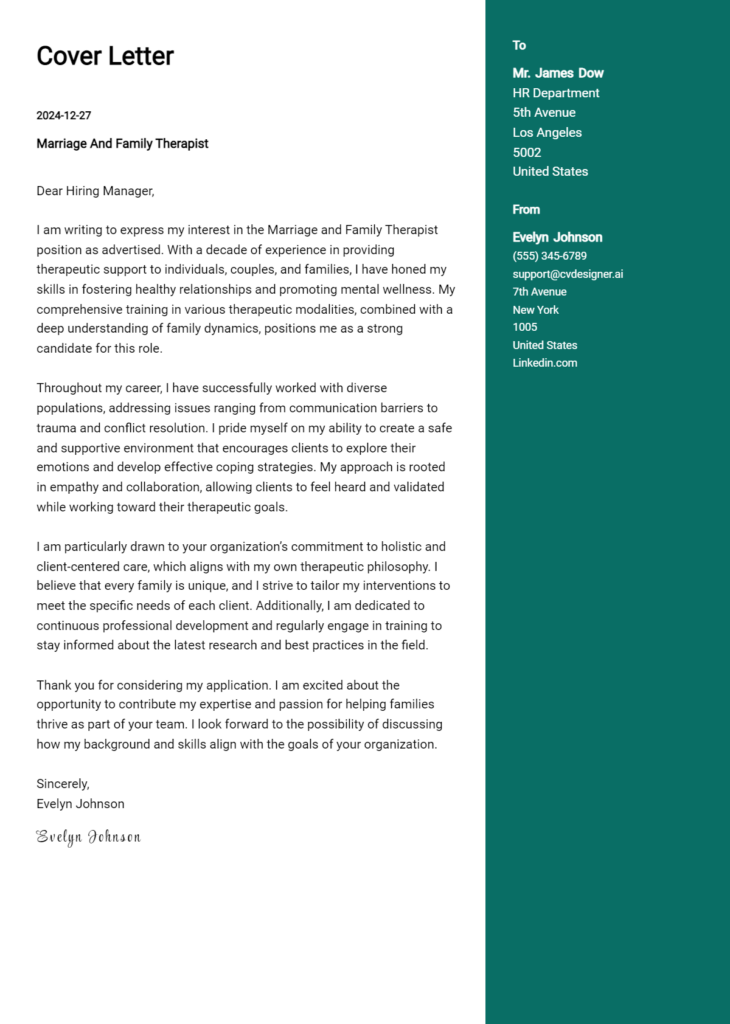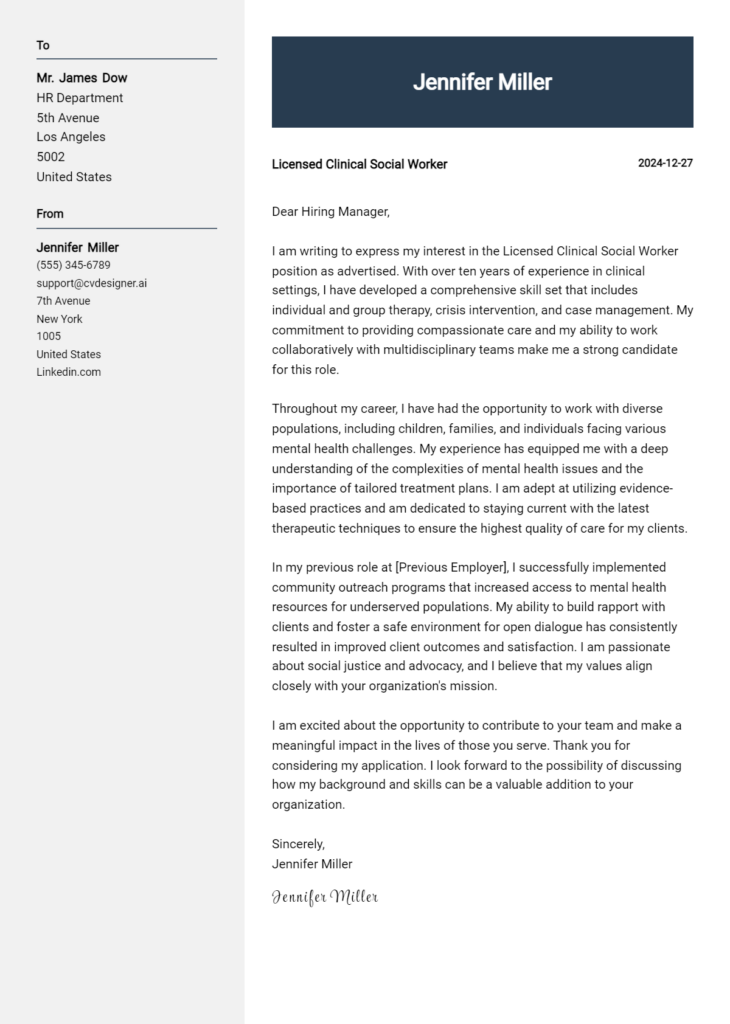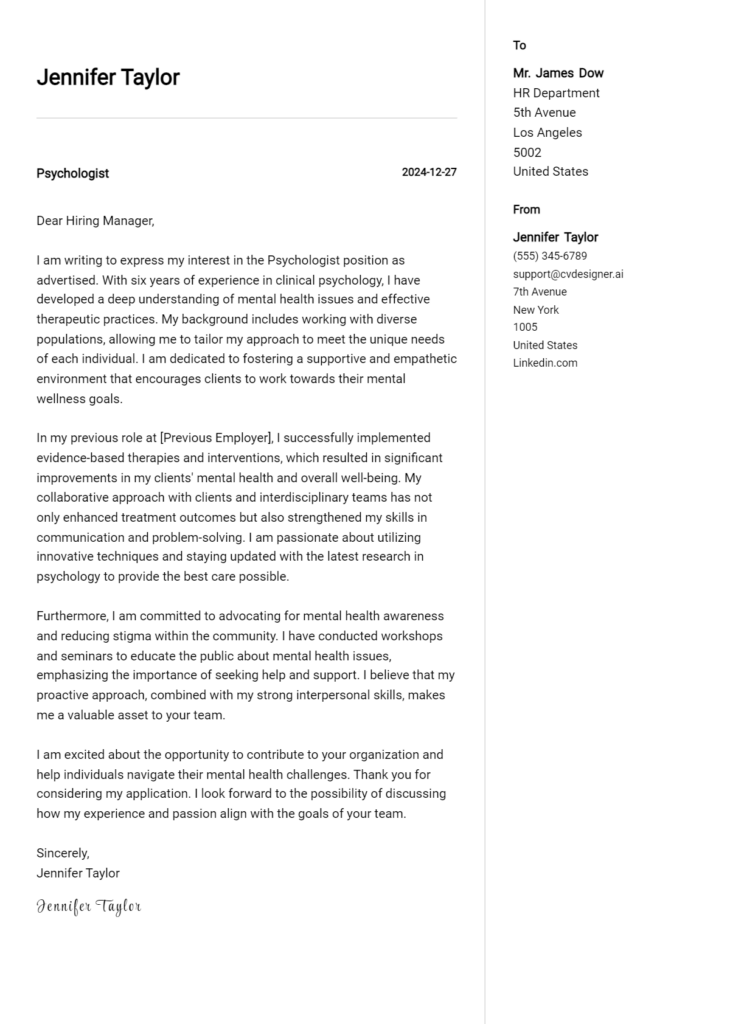Art Therapist Cover Letter Examples
Explore additional Art Therapist cover letter samples and guides and see what works for your level of experience or role.
How to Format an Art Therapist Cover Letter?
Crafting a compelling cover letter is essential for art therapists, as it serves as a window into your unique approach to healing through creativity. The way you format your cover letter can significantly impact how hiring managers perceive your skills and passion for the field. A well-structured cover letter not only showcases your artistic abilities but also reflects your empathy and understanding of clients’ needs—crucial traits for anyone in therapy.
In this guide, we'll explore how to effectively structure your cover letter, providing insights and art therapy-specific examples to help you create a persuasive document.
We'll focus on the essential components of a professional cover letter, including:
- Cover Letter Header
- Cover Letter Greeting
- Cover Letter Introduction
- Cover Letter Body
- Cover Letter Closing
Each section is vital in presenting your qualifications and professionalism. Let’s break down each part and explain how to make your art therapist cover letter shine.
Importance of Cover Letter Header for an Art Therapist
The cover letter header is a crucial element of your application as an Art Therapist, as it sets the tone for your professionalism and attention to detail. It should clearly include your contact information, the date, and the recipient's details to establish a direct line of communication. A well-structured header not only enhances readability but also demonstrates your organizational skills—key attributes in therapeutic settings. Clarity and professionalism are paramount; you want the hiring manager to immediately recognize who you are, how to reach you, and the context of your application.
Strong Example
Jane Doe 123 Art Therapy Lane Creative City, CA 12345 jane.doe@email.com (123) 456-7890 October 20, 2023 Mr. John Smith Director of Human Resources Healing Arts Center 456 Wellness Way Creative City, CA 12345
Weak Example
jane doe 10/20/23 to whom it may concern
The Importance of a Strong Cover Letter Greeting for an Art Therapist
The greeting of a cover letter serves as the first impression for the hiring manager and sets the tone for the entire document. A well-crafted greeting not only demonstrates professionalism but also adds a personal touch by addressing the recipient directly. This approach shows that you have taken the time to tailor your application, indicating a genuine interest in the position. To avoid generic greetings, it's crucial to research the hiring manager's name or the specific title of the person you are addressing. A personalized greeting can make your application stand out from the rest.
Here are some tips for crafting an effective greeting:
- Always try to find the hiring manager's name through the company website, LinkedIn, or by calling the office.
- If the name is not available, consider addressing the hiring team or using a job title that reflects the role.
- Avoid using "To Whom It May Concern" or similar generic phrases, as they can come off as impersonal.
Strong Greeting Example
Dear Ms. Johnson,
Weak Greeting Example
To Whom It May Concern,
Importance of a Well-Crafted Cover Letter Introduction for an Art Therapist
A well-crafted cover letter introduction is essential for an Art Therapist because it serves as the first impression to the hiring manager. This introduction should not only capture attention but also convey genuine interest in the role and highlight key skills or achievements that make the candidate a strong fit. A compelling introduction can set the tone for the rest of the application, demonstrating passion for art therapy and a clear understanding of the therapeutic impact of creative expression. Conversely, a weak introduction may fail to engage the reader, resulting in missed opportunities for the candidate.
Strong Example
Dear [Hiring Manager's Name], As a passionate Art Therapist with over five years of experience working with diverse populations, I am thrilled to apply for the position at [Company Name]. My dedication to fostering healing through creative expression has led to significant improvements in my clients' emotional well-being and self-awareness. I am eager to bring my expertise in therapeutic techniques and my commitment to inclusivity to your esteemed team.
Weak Example
To Whom It May Concern, I am writing to apply for the Art Therapist position at your organization. I have some experience in art and therapy, and I think I would be okay at this job. I hope you will consider my application.
Purpose of the Cover Letter Body for an Art Therapist
The body of a cover letter for an Art Therapist serves as a critical opportunity for candidates to articulate their unique skills, relevant experiences, and the value they can bring to the organization. This section allows applicants to highlight specific projects or accomplishments that demonstrate their effectiveness in using art as a therapeutic tool. By presenting concrete examples, candidates can showcase their understanding of various therapeutic techniques, their ability to work with diverse populations, and their passion for promoting mental health through creative expression. A well-crafted cover letter body can significantly enhance a candidate's chances of standing out in a competitive job market.
Strong Example
Dear [Hiring Manager's Name], I am excited to apply for the Art Therapist position at [Company Name]. With over five years of experience in art therapy, I have successfully implemented programs that support individuals dealing with trauma and anxiety. For instance, while working at [Previous Organization], I developed a community art project that engaged over 50 participants, resulting in a 30% improvement in reported emotional wellbeing as measured by pre- and post-program surveys. My background in both fine arts and psychology allows me to create customized therapeutic interventions that resonate with clients. I am eager to bring my skills in facilitating expressive art workshops to [Company Name], where I believe I can contribute positively to your mission of enhancing mental health through holistic approaches.
Weak Example
Dear [Hiring Manager's Name], I am writing to apply for the Art Therapist position at [Company Name]. I have some experience in art therapy and I like helping people. In my last job, I did some art projects with clients. I think being an art therapist is important and I want to work at your company because it seems nice. I hope you consider my application. Thank you, [Your Name]
The Importance of the Cover Letter Closing for an Art Therapist
The closing paragraph of a cover letter is crucial as it serves to encapsulate your qualifications, express your enthusiasm for the role, and prompt the employer to take the next steps—whether that’s reviewing your resume or scheduling an interview. A strong closing can leave a lasting impression and reinforce your suitability for the position, while a weak closing may diminish the impact of your application. It’s essential to be assertive yet courteous, ensuring that you convey your eagerness to discuss how your skills can contribute to the organization.
Strong Example
Thank you for considering my application for the Art Therapist position at [Organization Name]. With my extensive experience in facilitating therapeutic art sessions and my passion for helping individuals express themselves creatively, I am excited about the opportunity to contribute to your team. I look forward to the possibility of discussing how I can support your clients in their healing journeys. Please feel free to contact me to schedule an interview at your convenience. I have attached my resume for your review.
Weak Example
I hope you think about my application for the Art Therapist job. I have some experience and would like to work there. Please check my resume. Thanks.
These tips will help candidates craft an effective cover letter for an Art Therapist position, emphasizing the importance of showcasing technical skills, problem-solving abilities, knowledge of the therapeutic process, teamwork, and a passion for continuous learning. A well-written cover letter can set you apart from other candidates, allowing you to demonstrate your unique qualifications and commitment to the role.
Tips for Crafting an Effective Cover Letter for Art Therapists
Highlight Your Technical Skills
In the field of art therapy, it's essential to demonstrate your proficiency in various art techniques and therapeutic methodologies. Be sure to include specific skills such as knowledge of different media (paint, clay, digital art), familiarity with therapeutic frameworks (Cognitive Behavioral Therapy, Gestalt therapy), and your ability to adapt art interventions to meet individual client needs. This not only showcases your technical expertise but also your versatility as a therapist.Demonstrate Problem-Solving Abilities
As an art therapist, you will encounter diverse challenges that require innovative solutions. In your cover letter, provide examples of how you've navigated difficult situations in previous roles, such as addressing a client’s specific emotional needs through tailored art activities or adjusting your approach based on client feedback. Highlighting your problem-solving skills will show potential employers that you can think critically and adapt your strategies effectively.Showcase Your Knowledge of the Therapeutic Process
Employers appreciate candidates who understand the nuances of the therapeutic process. Use your cover letter to discuss your knowledge of the stages of therapy, the importance of building rapport with clients, and how you evaluate the effectiveness of art interventions. This understanding demonstrates your commitment to best practices in art therapy and your readiness to contribute positively to their team.Emphasize Teamwork and Collaboration
Art therapy often involves working alongside other healthcare professionals, such as psychologists, social workers, and educators. Highlight your experience in collaborative settings and your ability to communicate effectively with colleagues. Discuss any instances where you contributed to multidisciplinary teams, showcasing your ability to work towards common goals and integrate diverse perspectives into your therapeutic practice.Express Your Passion for Continuous Learning
The field of art therapy is ever-evolving, and a commitment to lifelong learning is crucial. Mention any relevant courses, workshops, or certifications you have pursued to expand your knowledge and skills. By expressing your dedication to professional growth, you signal to potential employers that you are proactive about staying current with best practices and innovations in the field.
For additional assistance in creating your cover letter, consider using cover letter templates or try a cover letter builder to help format and structure your content effectively.
Common Mistakes to Avoid in an Art Therapist Cover Letter
Crafting a compelling cover letter is essential for standing out in the competitive field of art therapy. Avoiding common mistakes can significantly enhance your chances of making a positive impression on potential employers. Here are some pitfalls to watch out for:
Generic Greetings: Using a generic salutation like "To Whom It May Concern" can make your letter feel impersonal. Always try to address your letter to a specific individual, if possible.
Lack of Specificity: Failing to tailor your cover letter to the specific art therapy position can lead to a lack of engagement. Be sure to highlight relevant experiences and skills that align with the job description.
Overly Formal Language: While professionalism is important, overly formal language can create distance. Aim for a conversational tone that reflects your personality and passion for art therapy.
Ignoring the Structure: A poorly formatted cover letter can detract from your message. Ensure that your letter follows a clear cover letter format and includes a compelling introduction, body, and conclusion.
Focusing Too Much on Yourself: While it's essential to showcase your qualifications, remember to emphasize how your skills can benefit the organization and its clients.
Neglecting Proofreading: Spelling and grammatical errors can undermine your professionalism. Always proofread your cover letter or have someone else review it before submitting.
Not Including a Call to Action: Failing to express your enthusiasm for the position and inviting further communication can leave your letter feeling incomplete. Conclude with a strong call to action.
By being mindful of these common mistakes and utilizing cover letter examples for inspiration, you can create a thoughtful and polished cover letter that speaks to your qualifications as an art therapist.
Cover Letter FAQs for Art Therapist
What should I include in my cover letter as an Art Therapist?
In your cover letter for an Art Therapist position, you should begin with a strong introduction that outlines your passion for art therapy and the specific role you are applying for. Highlight your relevant qualifications, such as your degree in art therapy or related fields, and any certifications you hold. Discuss your clinical experience, emphasizing any specialized populations you’ve worked with, such as children, veterans, or individuals with trauma. Additionally, include examples of how you’ve successfully used art as a therapeutic tool to foster healing and self-expression. Finally, conclude with a strong closing statement expressing your enthusiasm for the position and your desire to contribute to the organization’s mission.
How can I demonstrate my skills and experience in my cover letter?
To effectively demonstrate your skills and experience in your cover letter, use specific examples from your work history. Discuss particular cases where you employed art therapy techniques and the positive outcomes you achieved. For instance, mention how you helped clients express emotions through painting or sculpture and how this led to breakthroughs in their therapy. You can also highlight any workshops or community programs you’ve facilitated that showcase your ability to create inclusive and supportive environments. Additionally, incorporating metrics, such as improved client engagement or successful program completion rates, can provide concrete evidence of your impact and effectiveness as an Art Therapist.
Should I tailor my cover letter for each job application?
Yes, tailoring your cover letter for each job application is crucial. Each organization may have different values, client populations, and therapeutic approaches. By customizing your cover letter, you can demonstrate your genuine interest in the specific position and show that you’ve researched the organization. Mentioning the organization’s mission or values and aligning your personal philosophy with theirs can create a strong connection. Additionally, addressing how your unique skills and experiences match the specific requirements of the job will make your application stand out. A personalized cover letter shows potential employers that you are not just sending out generic applications but are truly invested in the opportunity.
What tone should I use in my cover letter for an Art Therapist position?
The tone of your cover letter should be professional yet empathetic and compassionate, reflecting the nature of your role as an Art Therapist. Use clear and concise language while maintaining warmth and sincerity. Since art therapy involves emotional and personal experiences, it’s essential to convey your understanding of the therapeutic process and the importance of creating a safe space for clients. Your passion for art and therapy should shine through, so feel free to express your enthusiasm for helping others through creative expression. Avoid overly formal or technical language; instead, aim for a conversational yet respectful tone that resonates with your potential employer and reflects your personality as a therapist.
Build your Cover Letter in minutes
Use an AI-powered cover letter builder and have your letter done in 5 minutes. Just select your template and our software will guide you through the process.

